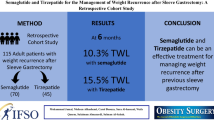Background
This report summarizes our 15-year experience with duodenal switch (DS) as a primary procedure on 1,423 patients from 1992 to 2005.
Methods
Within the last 2 years, follow-up of these patients, including clinical biochemistry evaluation by us or by their local physician is 97%.
Results
Survival rate was 92% after DS. The risk of death (Excess Hazard Ratio (EHR)) was 1.2, almost that of the general population. After a mean of 7.3 years (range 2–15), 92% of patients with an initial BMI ≤50 kg/m2 obtained a BMI ;< 35 and 83% of those with an initial BMI > 50 obtained a BMI ;< 40. Diabetes was cured (i.e. medication was discontinued) in 92% and medication decreased in the others. The use of the CPAP apparatus was discontinued in 90%, medication for asthma was decreased in 88%, and the prevalence of a cardiac risk index >5 was decreased by 86%. Patients’ satisfaction in regard to weight loss was graded 3.6 on a basis of 5, and 95% of patients were satisfied with the overall results. Operative mortality was 1% which is comparable with gastric bypass surgery. The need for revision for malnutrition was rare (0.7%) and total reversal was exceptional (0.2%). Failure to lose >25% of initial excess weight was 1.3%. Revision for failure to lose sufficient weight was needed in only 1.5%. Severe anemia, deficiency in vitamins or bone damage were exceptional, easily treatable, preventable and no permanent damage was documented.
Conclusion
In the long term, DS was very efficient in terms of cure rate for morbid obesity and its comorbidities. In terms of risk/benefit, DS was very sucessful with an appropriate system of follow-up.
Similar content being viewed by others
References
Marceau P, Hould FS, Lebel S et al. Malabsorptive obesity surgery. Surg Clin North Am 2001; 81: 1113–27.
Marceau P, Hould FS, Simard S et al. Biliopancreatic diversion with duodenal switch. World J Surg 1998; 22: 947–54.
Holst JJ. Glucagonlike peptide 1: A newly discovered gastrointestinal hormone. Gastroenterol 1994; 107: 1848–55.
Ballinger A. Gastric inhibitory polypeptide links overnutrition to obesity. Science@lert. www.gutjnl.com
Rubino F, Marescaux J. Effect of duodenal-jejunal exclusion in a non-obese animal model of type 2 diabetes. Ann Surg 2004; 239: 1–11.
Marceau P. Contribution of bariatric surgery to the comprehension of morbid obesity. Obes Surg 2005; 15: 3–10.
Marceau S, Biron S, Lagacé M et al. Biliopancreatic diversion, with distal gastrectomy, 250 cm and 50 cm limbs: long-term results. Obes Surg 1995; 5: 302–7.
Flum DR, Dellinger EP. Impact of gastric bypass operation on survival: a population-based analysis. J Am Coll Surg 2004; 199: 543–51.
Institut de la Statistique Quebec 25 avril 2006. http://www.stat.gouv.qc.ca/donstat/societe/demographic/maison deces/307.htm
Katzmarzyk PT, Craig CL, Bouchard C. Underweight, overweight and obesity: relationships with mortality in the 13-year follow-up of the Canada Fitness Survey. J Clin Epidemiol 2001; 54: 916–20.
Sjostrom L, Narbro K, Sjostrom CD et al. Effects of bariatric surgery on mortality in Sweddish obese subjects. N Engl J Med 2007; 357: 741–52.
Ten-year follow-up of weight loss and quality of life after obesity treatment. Swedish obese subjects (SOS) – An intervention study of obesity. Quality of Life Res 2003; 12: 805.
DeMaria EJ, Portenier D, Wolfe L. Obesity surgery mortality risk score: proposal for a clinically useful score to predict mortality risk in patients undergoing gastric bypass. Surg Obes Rel Dis 2007; 3: 134–40.
Hamoui N, Chock B, Anthone GJ et al. Revision of the duodenal switch: indications, technique, and outcomes. J Am Coll Surg 2007; 204: 603–730.
Holick MF. High prevalence of vitamin D inadequacy and implications for health. Mayo Clin Proc 2006; 81: 353–73.
Parfitt AM, Podenphant J, Villanueva AR et al. Metabolic bone disease with and without osteomalacia after intestinal bypass surgery. Bone 1985; 6: 211–20.
Marceau P, Biron S, Lebel S et al. Does bone change after biliopancreatic diversion? J Gastrointest Surg 2002; 6: 690–8.
Blanchet C, Dodin S, Dumont M et al. Bone mineral density in French Canadian women. Osteoporosis Int 1998; 8: 268–73.
Palomar R, Fernandez-Fresnedo G, Dominguez-Diez A et al. Effects of weight loss after biliopancreatic diversion on metabolism and cardiovascular profile. Obes Surg 2005; 15: 794–8.
Wayne KN, Houghton SG, Dawn SM et al. Enteric hyperoxaluria, nephrolithiasis, and oxalate nephropathy potentially serious and unappreciated complications of Roux gastric bypass. Surg Obes Rel Dis 2005; 1: 481–5.
Nelson WK, Fatima J, Houghton SG et al. The malabsorptive very, very long limb Roux-en-Y gastric bypass for super obesity: results in 257 patients. Surgery 2006; 140: 517–23.
Brolin RE. Prospective, randomized evaluation of midline fascial closure in gastric bariatric operations. Am J Surg 1996; 172: 328–31.
Sugerman HJ, Kellum JM, Reines HD et al. Greater risk of incisional hernia with morbidly obese than steroiddependent patients and low recurrence with prefascial polypropylene mesh. Am J Surg 1996; 171: 80–4.
Author information
Authors and Affiliations
Corresponding author
Rights and permissions
About this article
Cite this article
Marceau, P., Biron, S., Hould, FS. et al. Duodenal Switch: Long-Term Results. OBES SURG 17, 1421–1430 (2007). https://doi.org/10.1007/s11695-008-9435-9
Received:
Accepted:
Published:
Issue Date:
DOI: https://doi.org/10.1007/s11695-008-9435-9




